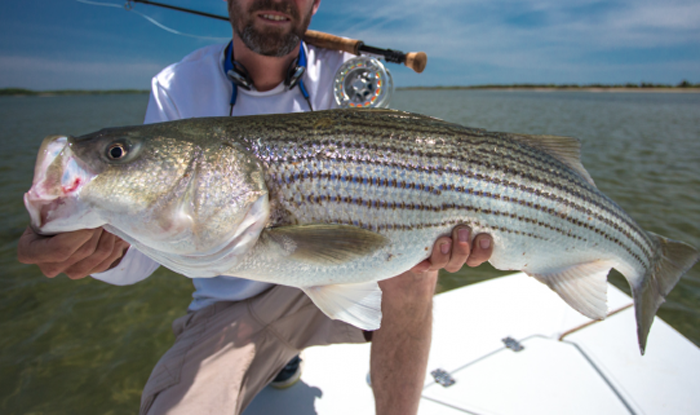
This springtime Long Island Sound, NY, flats caught striper bass required a quick, long, and accurate fly caster on deck. Capt. Andrew Derr photo.
Survival of the fittest
There are anomalies and exceptions to Darwinian behavior in the wild. But the daily reality is that the infirmed, weak, and the old are first on the predation menu for the strongest and fittest beasts of prey.
We know of this sometimes seemingly cruel exhibition of life and death through reading Charles Darwin’s The Origin of Species. We know it by watching documentaries and National Geographic nature specials about the animal kingdom’s cycle of life and death. If we live in the country or hunt and fish often, we have witnessed the survival of the fittest.
In the world of game fish, Darwin’s order of predation is intact
Not too long ago, expounders of new thinking in our fly-angling world started advancing the idea that big fish eat big things. Successes were manifested in big streamers, then articulated streamers with a second trailer hook, and it has been off to the races – big fish eat big “things” ever since.
The missed clue
What was going on with big, articulated “streamer” flies was that they were being swum like a wounded “thing,” wittingly or unwittingly. Pro guides picked up on the how and why, sometimes quickly and sometimes slowly. Their big flies started to get tied with a fat head and a tail that undulated, collapsed, listed, and, when pulled, had an up-and-down motion. And when tugged left and right, it’s a crippled creature.
As on land, aqua predators go after a meal that takes up the least energy. A trout, for example, will only expend as much energy as the prey can provide. It will not burn up a burger’s worth of calories to catch the calories in one fry.
In fly tying magazines, fly fishing publications, fly shops, and fly fishing shows, apostles of this new and better tying technique sold parishioners the idea of big, articulated flies catching big fish. Streamer fishing has been on fast-forward for quite a while.
The new “invention” was old hat to tournament bass anglers
Many of the techniques used by bass anglers are today’s fly fisher tools. However, the most evident knowledge transfer has been how to swim a lure (fly).

Bob Popovics from Seaside Park, New Jersey, is as innovative in his fly tying as George Sawley is to skiff boat building. Anyone spending ten minutes with Popovics comes away with something new, useable tying tips. Photo taken by Skip Clement at Renzetti factory in Titusville, Florida around 2011. Popovics book, Pop Fleyes is outstanding.
I can remember our editor, Capt Andrew Derr, with housemate Capt. Paul Dixon and visitors Bob Popovics and Ed Jaworowski talking about a new ‘bonefish” fly in the kitchen (1998).
Although Andrew’s rental was on the water in Key Largo, the pad’s pool became a proving ground for the “new” fly. As we all watched, Paul added about 10 feet of mono-tied off the fly and swam it once. A collective conclusion was made in seconds. It didn’t swim right!
Moral of the day. It’s how the fly swims that catch the fish (or how “you” swim it)


